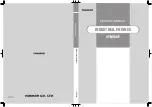
Rev. 3.0, 04/02, page 483 of 1064
Bit 0—DMAC Master Enable (DME): Enables activation of the entire DMAC. When the DME
bit and the DE bit of the CHCR register for the corresponding channel are set to 1, that channel is
enabled for transfer. If this bit is cleared during data transfer, transfers on all channels are
suspended.
Even if the DME bit has been set, transfer is not enabled when TE is 1 or DE is 0 in CHCR, or
when the NMI or AE bit in DMAOR is 1.
Bit 0: DME
Description
0
Operation disabled on all channels
(Initial value)
1
Operation enabled on all channels
14.3
Operation
When a DMA transfer request is issued, the DMAC starts the transfer according to the
predetermined channel priority order. It ends the transfer when the transfer end conditions are
satisfied. Transfers can be requested in three modes: auto-request, external request, and on-chip
peripheral module request. There are two modes for DMA transfer: single address mode and dual
address mode. Either burst mode or cycle steal mode can be selected as the bus mode.
14.3.1
DMA Transfer Procedure
After the desired transfer conditions have been set in the DMA source address register (SAR),
DMA destination address register (DAR), DMA transfer count register (DMATCR), DMA
channel control register (CHCR), and DMA operation register (DMAOR), the DMAC transfers
data according to the following procedure:
1. The DMAC checks to see if transfer is enabled (DE = 1, DME = 1, TE = 0, NMIF = 0, AE =
0).
2. When a transfer request is issued and transfer has been enabled, the DMAC transfers one
transfer unit of data (determined by the setting of TS2–TS0). In auto-request mode, the transfer
begins automatically when the DE bit and DME bit are set to 1. The DMATCR value is
decremented by 1 for each transfer. The actual transfer flow depends on the address mode and
bus mode.
3. When the specified number of transfers have been completed (when the DMATCR value
reaches 0), the transfer ends normally. If the IE bit in CHCR is set to 1 at this time, a DMTE
interrupt request is sent to the CPU.
4. If a DMAC address error or NMI interrupt occurs, the transfer is suspended. Transfer is also
suspended when the DE bit in CHCR or the DME bit in DMAOR is cleared to 0. In the event
of an address error, a DMAE interrupt request is forcibly sent to the CPU.
Figure 14.2 shows a flowchart of this procedure.
Summary of Contents for SH7751
Page 39: ...Rev 3 0 04 02 page xxxviii of xxxviii ...
Page 89: ...Rev 3 0 04 02 page 50 of 1064 ...
Page 157: ...Rev 3 0 04 02 page 118 of 1064 ...
Page 193: ...Rev 3 0 04 02 page 154 of 1064 ...
Page 225: ...Rev 3 0 04 02 page 186 of 1064 ...
Page 253: ...Rev 3 0 04 02 page 214 of 1064 ...
Page 301: ...Rev 3 0 04 02 page 262 of 1064 ...
Page 343: ...Rev 3 0 04 02 page 304 of 1064 ...
Page 607: ...Rev 3 0 04 02 page 568 of 1064 ...
Page 671: ...Rev 3 0 04 02 page 632 of 1064 ...
Page 745: ...Rev 3 0 04 02 page 706 of 1064 ...
Page 767: ...Rev 3 0 04 02 page 728 of 1064 ...
Page 1061: ...Rev 3 0 04 02 page 1022 of 1064 NMI tNMIL tNMIH Figure 23 69 NMI Input Timing ...
Page 1069: ...Rev 3 0 04 02 page 1030 of 1064 ...
Page 1103: ...Rev 3 0 04 02 page 1064 of 1064 ...
















































